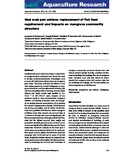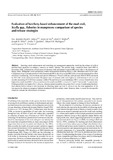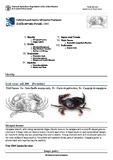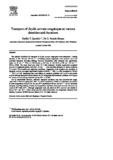Search
Now showing items 1-10 of 43
Economic feasibility analysis of the monoculture of mudcrab (Scylla serrata) Forsskal
Mudcrabs, Scylla serrata Forsskal, were monocultured at different stocking densities: 5000, 10 000, 15 000 and 20 000/ha for 90 days. Highest mean weight, survival and relative growth increment (P>0.05) were obtained from ...
Mud crab pen culture: replacement of fish feed requirement and impacts on mangrove community structure
(Blackwell Publishing, 2010)
Brackishwater pond culture has been a major factor in mangrove loss in Southeast Asia, hence, the need to develop environment-friendly technologies such as mud crab Scylla (Portunidae) culture in mangrove pens exists. This ...
Induction of moulting in hatchery-reared mangrove crab Scylla serrata juveniles through temperature manipulation or autotomy
(Wiley, 2019)
The effects of temperature and autotomy of chelipeds on survival, growth and moulting of mangrove crab (Scylla serrata) juveniles were investigated under laboratory conditions for 60 days. Hatchery‐produced crabs with ...
Evaluation of hatchery-based enhancement of the mud crab, Scylla spp., fisheries in mangroves: comparison of species and release strategies
(CSIRO Publishing, 2009)
Ranching, stock enhancement and restocking are management approaches involving the release of wild or hatchery-bred organisms to enhance, conserve or restore fisheries. The present study, conducted from April 2002 to ...
Community-based technology transfer in rural aquaculture: The case of mudcrab Scylla serrata nursery in ponds in northern Samar, central Philippines
(Springer Verlag, 2014)
Finding aquaculture development approaches to open up livelihood opportunities for the rural poor and in mainstreaming smallholder fish farmers to reduce poverty remain a challenge. This paper examines the community-based ...
Cultured Aquatic Species Information Programme - Scylla serrata (Forsskål, 1755)
(Food and Agriculture Organization of the United Nations, 2015)
Transport of Scylla serrata megalopae at various densities and durations
(Elsevier, 2000)
The optimal conditions for transport of Scylla serrata megalopae were determined. Loading densities of 50, 100 and 150 ind l<sup>−1</sup> of hatchery-reared megalopae were studied over a 6-h simulated transport, including ...
Amino acid profiles in the midgut, ovary, developing eggs and zoea of the mud crab, Scylla serrata
(Society of Israeli Aquaculture and Marine Biotechnology, 2004)
Culture of the mud crab, Scylla serrata, is beset by low and inconsistent survival of larvae in spite of the high fecundity of crab breeders. The nutrition of the embryo and pre-feeding zoea depends on what is stored in ...
Formalin as an alternative to trifluralin as prophylaxis against fungal infection in mud crab Scylla serrata (Forsskål) larvae
(Blackwell Publishing, 2007)
The toxicity of formalin and trifluralin to the larval stages of the mud crab Scylla serrata was compared in a static bioassay. Prophylactic doses of 5, 10, 15, 20 and 25 μg L<sup>−1</sup> formalin and 0.05, 0.1, ...
Seed production of Charybdis feriatus (Linnaeus)
(Blackwell Publishing, 2007)
Some aspects of the reproductive biology of Charybdis feriatus (Linnaeus) were investigated to identify suitable techniques for broodstock management and seed production. Likewise, factors such as ablation, water depth and ...











